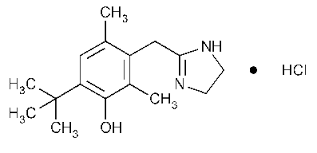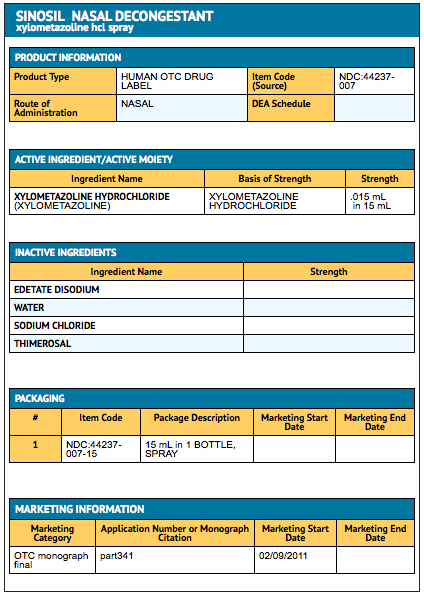Xylometazoline
Editor-In-Chief: C. Michael Gibson, M.S., M.D. [1]; Associate Editor(s)-in-Chief: Alberto Plate [2]
Disclaimer
WikiDoc MAKES NO GUARANTEE OF VALIDITY. WikiDoc is not a professional health care provider, nor is it a suitable replacement for a licensed healthcare provider. WikiDoc is intended to be an educational tool, not a tool for any form of healthcare delivery. The educational content on WikiDoc drug pages is based upon the FDA package insert, National Library of Medicine content and practice guidelines / consensus statements. WikiDoc does not promote the administration of any medication or device that is not consistent with its labeling. Please read our full disclaimer here.
Overview
Xylometazoline is a sympathomimetic, descongestant that is FDA approved for the treatment of nasal congestion due to cold, hay fever or other respiratory allergies. Common adverse reactions include rhinitis medicamentosa, atrophic rhinitis, sinusitis and otitis media.
Adult Indications and Dosage
FDA-Labeled Indications and Dosage (Adult)
Cold, Hay Fever or Allergies
- Dosage: 2 or 3 sprays in each nostril not more often than every 8 to 10 hours.
Off-Label Use and Dosage (Adult)
Guideline-Supported Use
There is limited information regarding Off-Label Guideline-Supported Use of Xylometazoline in adult patients.
Non–Guideline-Supported Use
There is limited information regarding Off-Label Non–Guideline-Supported Use of Xylometazoline in adult patients.
Pediatric Indications and Dosage
FDA-Labeled Indications and Dosage (Pediatric)
Cold, Hay Fever or Allergies
- Dosage: Only for pediatric patients > 12 years old. Use 2 or 3 sprays in each nostril not more often than every 8 to 10 hours.
Off-Label Use and Dosage (Pediatric)
Guideline-Supported Use
There is limited information regarding Off-Label Guideline-Supported Use of Xylometazoline in pediatric patients.
Non–Guideline-Supported Use
There is limited information regarding Off-Label Non–Guideline-Supported Use of Xylometazoline in pediatric patients.
Contraindications
There is limited information regarding Xylometazoline Contraindications in the drug label.
Warnings
When using this product:
- Do not use this product for more than 3 days. Use only as directed. Frequent or prolonged use may cause nasal congestion to recur or worsen. If symptoms persist, consult a doctor.
- This product may cause temporary discomfort such as burning, stinging, sneezing or an increase in nasal discharge.
- The use of this container by more than one person may spread infection.
Adverse Reactions
Clinical Trials Experience
There is limited information regarding Xylometazoline Clinical Trials Experience in the drug label.
Postmarketing Experience
There is limited information regarding Xylometazoline Postmarketing Experience in the drug label.
Drug Interactions
There is limited information regarding Xylometazoline Drug Interactions in the drug label.
Use in Specific Populations
Pregnancy
Pregnancy Category (FDA):
Consult your physician before using.
Pregnancy Category (AUS):
There is no Australian Drug Evaluation Committee (ADEC) guidance on usage of Xylometazoline in women who are pregnant.
Labor and Delivery
There is no FDA guidance on use of Xylometazoline during labor and delivery.
Nursing Mothers
Consult your physician before using.
Pediatric Use
Keep out of reach of children if swallowed, get medical help or contact a Poison Control Center right away.
Geriatic Use
There is no FDA guidance on the use of Xylometazoline in geriatric settings.
Gender
There is no FDA guidance on the use of Xylometazoline with respect to specific gender populations.
Race
There is no FDA guidance on the use of Xylometazoline with respect to specific racial populations.
Renal Impairment
There is no FDA guidance on the use of Xylometazoline in patients with renal impairment.
Hepatic Impairment
There is no FDA guidance on the use of Xylometazoline in patients with hepatic impairment.
Females of Reproductive Potential and Males
There is no FDA guidance on the use of Xylometazoline in women of reproductive potentials and males.
Immunocompromised Patients
There is no FDA guidance one the use of Xylometazoline in patients who are immunocompromised.
Administration and Monitoring
Administration
There is limited information regarding Xylometazoline Administration in the drug label.
Monitoring
There is limited information regarding Xylometazoline Monitoring in the drug label.
IV Compatibility
There is limited information regarding the compatibility of Xylometazoline and IV administrations.
Overdosage
There is limited information regarding Xylometazoline overdosage. If you suspect drug poisoning or overdose, please contact the National Poison Help hotline (1-800-222-1222) immediately.
Pharmacology

| |
Xylometazoline
| |
| Systematic (IUPAC) name | |
| 3-(4,5-dihydro-1H-imidazol-2-ylmethyl)- 2,4-dimethyl-6-tert-butyl-phenol | |
| Identifiers | |
| CAS number | |
| ATC code | R01 R01AB07 (WHO) (combinations), S01GA04 (WHO) |
| PubChem | |
| DrugBank | |
| Chemical data | |
| Formula | Template:OrganicBox atomTemplate:OrganicBox atomTemplate:OrganicBoxTemplate:OrganicBoxTemplate:OrganicBoxTemplate:OrganicBoxTemplate:OrganicBoxTemplate:OrganicBoxTemplate:OrganicBoxTemplate:OrganicBoxTemplate:OrganicBoxTemplate:OrganicBoxTemplate:OrganicBoxTemplate:OrganicBox atomTemplate:OrganicBoxTemplate:OrganicBox atomTemplate:OrganicBoxTemplate:OrganicBoxTemplate:OrganicBoxTemplate:OrganicBoxTemplate:OrganicBoxTemplate:OrganicBoxTemplate:OrganicBox |
| Mol. mass | 260.375 g·mol−1 |
| SMILES | & |
| Physical data | |
| Melt. point | 301.5 °C (575 °F) |
| Pharmacokinetic data | |
| Bioavailability | ? |
| Metabolism | Kidney (30%), Fecal (10%) |
| Half life | 5-6 hours |
| Excretion | ? |
| Therapeutic considerations | |
| Pregnancy cat. |
C |
| Legal status | |
| Dependence Liability | Moderate |
| Routes | intranasal |
Mechanism of Action
Sympathomimetic drug, alpha receptor agonist, which constricts nasal vasculature.
Structure

Pharmacodynamics
There is limited information regarding Xylometazoline Pharmacodynamics in the drug label.
Pharmacokinetics
There is limited information regarding Xylometazoline Pharmacokinetics in the drug label.
Nonclinical Toxicology
There is limited information regarding Xylometazoline Nonclinical Toxicology in the drug label.
Clinical Studies
There is limited information regarding Xylometazoline Clinical Studies in the drug label.
How Supplied
There is limited information regarding Xylometazoline How Supplied in the drug label.
Storage
Store at 20-25 degrees C (68-77 degrees F)
Images
Drug Images
{{#ask: Page Name::Xylometazoline |?Pill Name |?Drug Name |?Pill Ingred |?Pill Imprint |?Pill Dosage |?Pill Color |?Pill Shape |?Pill Size (mm) |?Pill Scoring |?NDC |?Drug Author |format=template |template=DrugPageImages |mainlabel=- |sort=Pill Name }}
Package and Label Display Panel

{{#ask: Label Page::Xylometazoline |?Label Name |format=template |template=DrugLabelImages |mainlabel=- |sort=Label Page }}
Patient Counseling Information
There is limited information regarding Xylometazoline Patient Counseling Information in the drug label.
Precautions with Alcohol
Alcohol-Xylometazoline interaction has not been established. Talk to your doctor about the effects of taking alcohol with this medication.
Brand Names
Look-Alike Drug Names
There is limited information regarding Xylometazoline Look-Alike Drug Names in the drug label.
Drug Shortage Status
Price
References
The contents of this FDA label are provided by the National Library of Medicine.
{{#subobject:
|Label Page=Xylometazoline |Label Name=Oxymetazoline Package.png
}}
| Clinical data | |
|---|---|
| ATC code | |
| Identifiers | |
| |
| CAS Number | |
| PubChem CID | |
| E number | {{#property:P628}} |
| ECHA InfoCard | {{#property:P2566}}Lua error in Module:EditAtWikidata at line 36: attempt to index field 'wikibase' (a nil value). |
| Chemical and physical data | |
| Formula | C16H24N2 |
| Molar mass | 244.38 |
|
WikiDoc Resources for Xylometazoline |
|
Articles |
|---|
|
Most recent articles on Xylometazoline Most cited articles on Xylometazoline |
|
Media |
|
Powerpoint slides on Xylometazoline |
|
Evidence Based Medicine |
|
Clinical Trials |
|
Ongoing Trials on Xylometazoline at Clinical Trials.gov Trial results on Xylometazoline Clinical Trials on Xylometazoline at Google
|
|
Guidelines / Policies / Govt |
|
US National Guidelines Clearinghouse on Xylometazoline NICE Guidance on Xylometazoline
|
|
Books |
|
News |
|
Commentary |
|
Definitions |
|
Patient Resources / Community |
|
Patient resources on Xylometazoline Discussion groups on Xylometazoline Patient Handouts on Xylometazoline Directions to Hospitals Treating Xylometazoline Risk calculators and risk factors for Xylometazoline
|
|
Healthcare Provider Resources |
|
Causes & Risk Factors for Xylometazoline |
|
Continuing Medical Education (CME) |
|
International |
|
|
|
Business |
|
Experimental / Informatics |
Editor-In-Chief: C. Michael Gibson, M.S., M.D. [3]
Xylometazoline (Neo-Rinoleina®; Novorin®; Olynth®; Otriven®; Otrivin®; Otrivine®; Xymelin®) is a topical decongestant that is directly dosed into the nose, either as a spray or as drops.
Xylometazoline is marketed under the brand names Otrivine or Otrivin, with the standard adult dose being 0.1% w/v xylometazoline. The dose for children under 12 is 0.05%.
The drug works by constricting the blood vessels in the nose. The vasoconstriction means that there is less pressure in the capillaries and less water can filter out, thus less discharge is made. (If the colour of the nasal passage is observed, it is visibly paler after dosage.)
Xylometazoline is designed to mimic the molecular shape of adrenaline meaning that it binds to the same cell receptors adrenaline does. For this reason, it should not be used by people with high blood pressure, or other heart problems. (It acts mainly on alpha-adrenergic receptors.)
Unfortunately the vessels become resistant to the drug after prolonged dosing. The number of receptors decreases, and when the administration of the drug is ceased, chronic congestion can occur; this is called rhinitis medicamentosa, commonly referred to as rebound congestion. Moreover long-term overdosing can cause degenerative changes in nasal mucous membranes that pose another health problem.
bg:Ксилометазолин de:Xylometazolin hu:Xylometazolin nl:Xylometazoline fi:Ksylometatsoliini
- Pages with script errors
- E number from Wikidata
- ECHA InfoCard ID from Wikidata
- Chemical articles with unknown parameter in Infobox drug
- Infobox drug articles without a structure image
- Articles without EBI source
- Chemical pages without ChemSpiderID
- Chemical pages without DrugBank identifier
- Articles without KEGG source
- Articles without InChI source
- Articles without UNII source
- Drugs with no legal status
- Articles containing unverified chemical infoboxes
- Topical decongestants
- Imidazolines